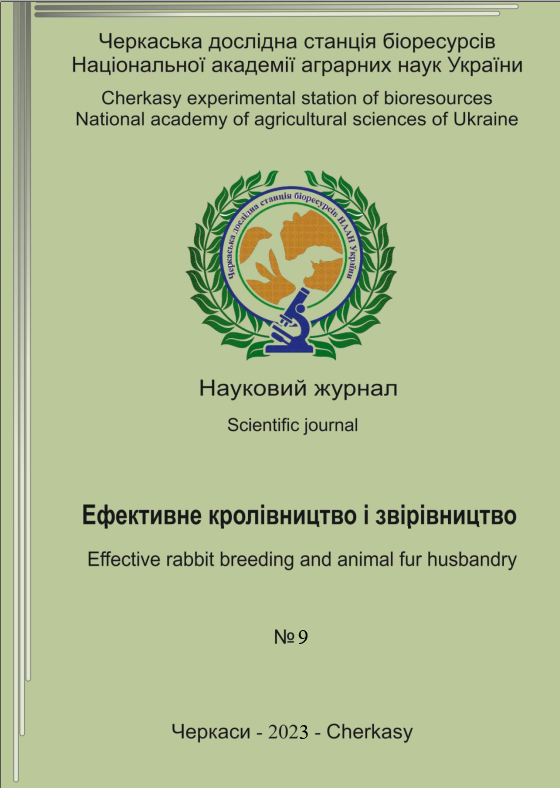DETERMINATION OF THE PRODUCTIVE EFFECT OF A COMPLETE RATION COMPOUND FEED, BALANCED ACCORDING TO INDIVIDUAL AVAILABLE AMINO ACIDS, ON THE GROWTH, DEVELOPMENT AND REPRODUCTIVE QUALITIES OF RABBITS
DOI:
https://doi.org/10.37617/2708-0617.2023.9.6-18Keywords:
rabbits, young animals, compound feed, recipe, amino acids, productivity, growth, developmentAbstract
The productive effect of a complete ration compound feed, balanced
according to international standards for individual available amino acids, on the
growth, development and functional state of the organism during the cultivation of
repair young rabbits was determined. Animals of the control (I) group were fed
granulated complete ration compound feed, in which the indicators of the content
of the main available amino acids (lysine, methionine and threonine) were not
taken into account during rationing, and the analogues of the experimental group
(II) - taking into account these factors - approximated in terms of nutrition. It was
established that the average live weight of animals in the control (I) group was
968.9 g, in the experimental (II) group - 965.7 g (difference 0.32%), and at the end
of the experiment - 2480.4 g and 2446.4 g , respectively (the difference of 1.39% is
statistically improbable). The absolute increase in live weight of animals was: in
the I-group - 1511.5 g, in the II-group - 1480.7 g (the difference - 2.08% is not
statistically probable). A similar trend was observed in terms of relative growth -
157.3% and 153.5%, respectively (a difference of 3.8%). When determining feed
costs, it was established that during the entire period of the experiment, per 1
head. 8.59 kg of combined feed was fed in the experimental group and 8.51 kg in
the control group (difference 0.93%), the average daily consumption was 179.0 g
and 177.3 g, respectively. Feed costs per 1 kg of live weight gain of young animals
were: in the II-group – 5.80 kg and in the I-group – 5.63 kg (difference – 0.17 kg
or 2.93%). The waist width of both groups of rabbits was 5.3 cm on average, and
the index of the comprehensive assessment of the young was 214.9 in the control
group and 211.0 in the experimental group; the difference was equal to 3.9 or
1.85% and was not probable. Thus, repair females of both groups during the
growth period from 42 to 90 days did not significantly differ among themselves in
terms of these parameters. Average pre-slaughter live weight 1 head. in the
experimental group it was 2461.3 g, and in the control group - 2457.5 g (difference
0.16%), the slaughter weight of the carcass was 1407.5 g and 1405.3 g (difference0.16%), respectively, the slaughter yield of the carcass in both groups – 57.2%, as
well as carcass length – 27.4 cm and 27.3 cm (difference 0.37%). The difference
between the groups according to all the above-mentioned indicators is statistically
improbable. No significant probable difference was found between the groups of
analogues and when weighing their internal organs. So, in particular, the weight
of the liver in the experimental group of animals was 56.8 g, in the control group -
57.0 g (difference 0.35%), kidneys - 16.5 g and 16.3 g, respectively (difference
1.21%), hearts - 6.5 g and 6.8 g (difference 4.62%), lungs – 14.0 g and 13.8 g
(difference 1.43%), as well as the total weight of skin 375.3 g and 373.0 g (a
difference of 0.61%). When measuring individual indicators of the linear
development of genital organs of repair females, it was established that the
average length of the double uterus in the II-group equaled 5.8 cm, and in the I-
group - 5.9 cm (difference - 1.72%) ; the average width of the uterus in both
groups was 1.3 cm. Thus, no significant difference was found between the groups
of analogues in these parameters as well. Thus, it can be concluded that the use of
full-rational granulated compound feed, developed according to international
standards, taking into account the rationing according to the content of individual
available amino acids, allows to reduce the content of crude protein in it - by
1.44%, as well as proportionally reduce the content of digestible energy - by
8.86% and crude fat - by 0.47%, which, in turn, helps to reduce the cost of feed
ingredients per 1 kg of live weight gain by 5.84%.


